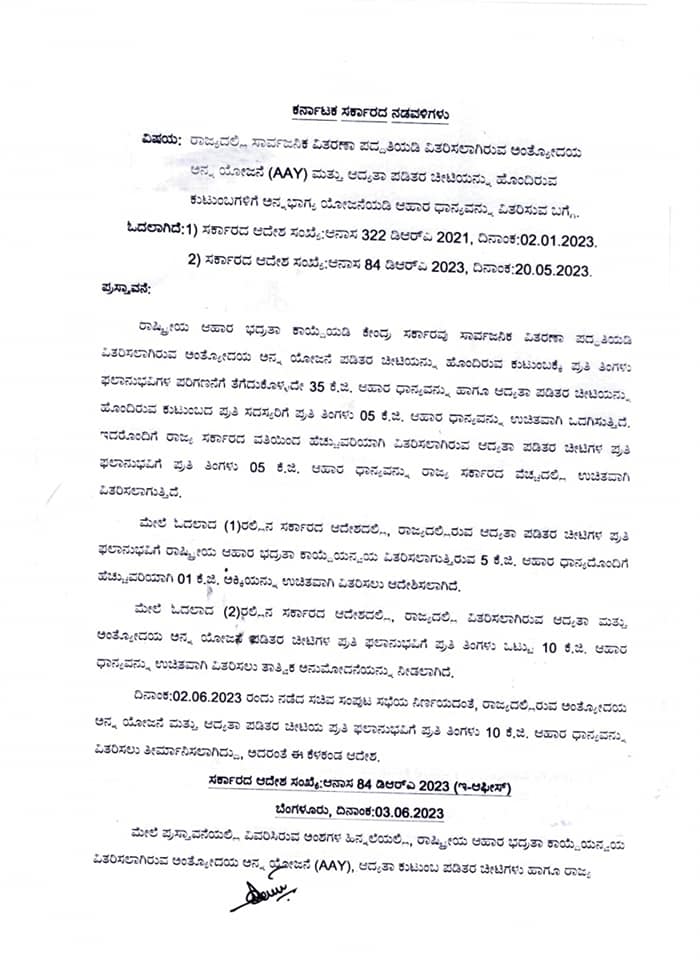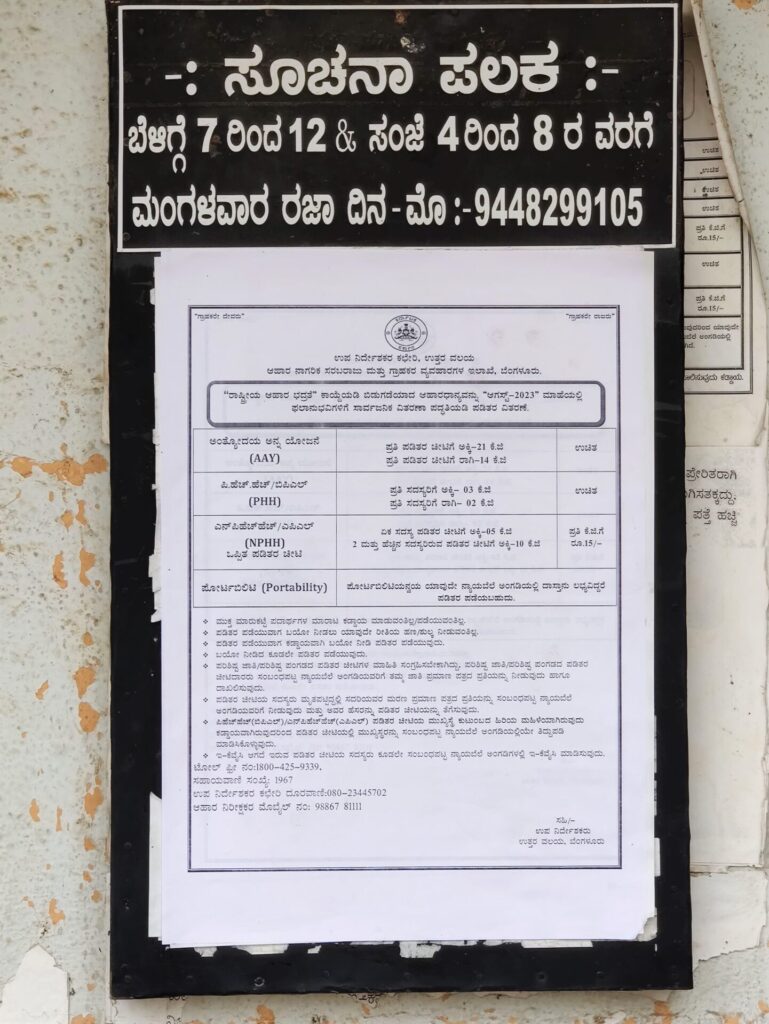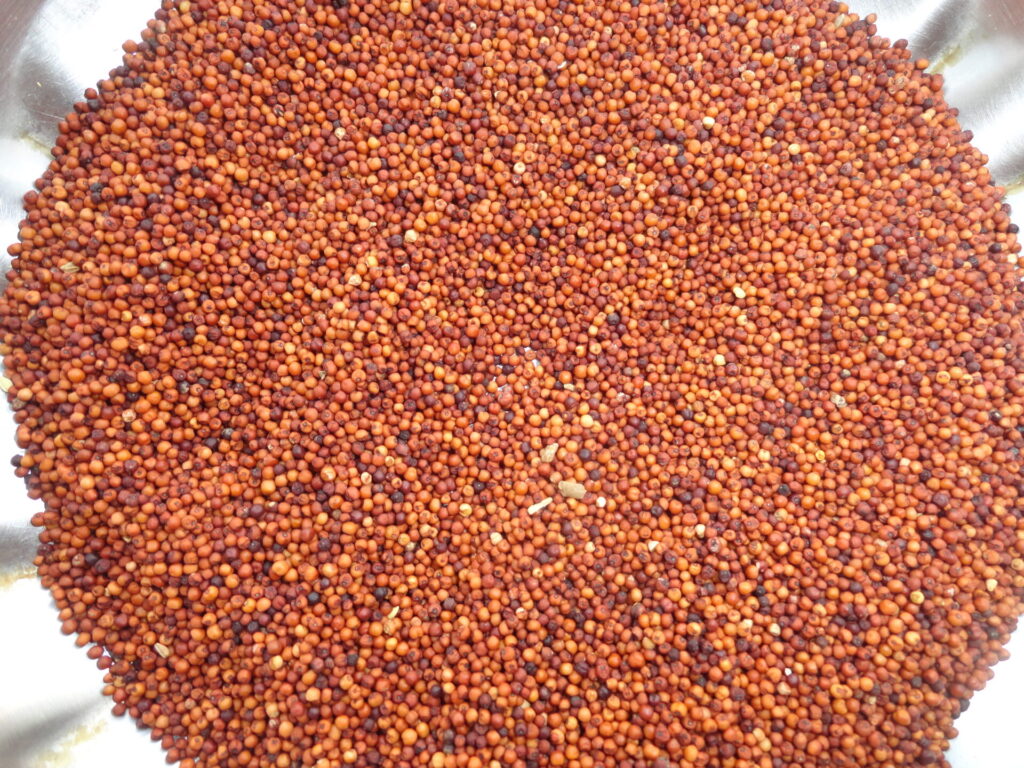When the Congress party came to power in May 2023, Priya* was excited. The domestic worker from North Bengaluru says she understands little about politics, but she knew about the five guarantees. Nearly four months after its victory, the state government is celebrating the fulfilment of at least four of the five guarantees. Priya, however, has mixed feelings about the schemes.
She agrees that at least two guarantees-free electricity and bus travel-have been fulfilled and she is now registered for the Gruha Lakshmi scheme. But the Anna Bhagya or free rice scheme has left her confused.
“I thought we would get 10 kgs of rice but we have got only 3 kgs. When I asked about it, the ration shop brushed me off,” she says.
During the elections and after forming the government, the Congress party had promised, under the Anna Bhagya scheme, to provide BPL card holders 10 kgs of rice per family member listed on ration cards. Anyone with a BPL or Antyodaya Card was eligible for the scheme. However, challenges with procurement of rice have hindered the progress of the scheme and the alternatives are not reaching all beneficiaries.
Anna Bhagya, a brief history
The Anna Bhagya scheme was first introduced in 2013 by the Siddaramaiah-led Congress government. At that time, the scheme allowed for 30kgs of rice per household. In 2018, the Yeddyurappa-led BJP government changed this to around 2 kgs of rice per household.
In 2019, the entire scheme was phased out and merged with the Central government’s PMGKY scheme, under which each household could get 5 kgs of food grains. The type of grains was to be region-specific. For instance, North Indian states supplied wheat while South Indian states, like Karnataka, supplied rice and ragi.
When Congress came back to power in 2023, they revived the Anna Bhagya scheme. However, despite initial promises, the recipients we spoke with can’t help but feel let down by the outcome. Although the scheme itself alludes to anna or rice in its name, rice is in short supply.
Read more: Price rise forcing Bengaluru’s poor to change their cooking and eating habits
Rice in short supply
The initial government order, passed in May 2023, ordered 10 kgs of food grains per person on a household’s ration card; the bulk of these food grains was supposed to be rice. However, Karnataka state does not have sufficient rice for the scheme.

The state attempted to procure the required rice from the Food Corporation of India (FCI), a department under the Central Government. Although FCI initially agreed, according to Chief Minister Siddaramaiah, the department later said it was unable to sell the required amount of rice.
Interestingly, FCI held an auction of surplus rice in Central Government granaries under the Open Market Sale Scheme in July. However, state governments were barred from participating in the auction. Only private players and traders were allowed to participate.
According to media reports, 99% of the rice stocks remained unsold in the auction. The state government alleges that the BJP-led central government was playing politics.
Counter measures
To counter this issue, the state government decided to reduce the amount of food grains supplied through ration shops and initiated cash transfers in lieu of the remaining rice.
As per the revamped Anna Bhagya scheme, recipients would now get 3 kgs of rice, 2 kgs of ragi and Rs 170 per person on the ration card. Each household can now get a maximum of 21 kgs of rice and 9 kgs of ragi.
Read more: Here’s how you can access the five guarantees promised by the new Karnataka government
It is a situation that has left many, like Priya, confused and unhappy. Two months after the Anna Bhagya scheme was initiated, many beneficiaries I spoke to raised two issues. Firstly, the rice was too little, and most did not consume ragi as much. Secondly, they weren’t clear about how the cash transfer was supposed to happen.

Unwanted ragi
Ratna is a pourakarmika from Jalahalli in North Bengaluru. For two months, she went to her assigned PDS shop hoping to procure 20 kgs of rice, for her family of two. In total, she received 6 kgs of rice and 2 kgs of ragi for her family of three. “We don’t eat ragi, so it is not useful for us.”
Ratna has to buy the remaining rice. She says her PDS store did not explain why she got only 6 kgs of rice instead of 9 kgs. “I was offered more ragi but I declined. No one eats ragi at home.”
Many beneficiaries were surprised that ragi was being given instead of rice. This partly appears to be because the scheme initially claimed rice would be given.
Indeed, the media widely reported that each eligible household would get 10 kgs of rice as part of the guarantee. However, the government order replaced rice with ‘food grains’, keeping the promise a little more open-ended.
At least Ratna gets the cash transfer to her account, although she is not sure of the exact amount. “My son checks my bank account for me. He said some money had been credited.”
With a college-going son and a husband forced into early retirement by injuries and paralysis at a construction job, saving money on rice is crucial to make ends meet. “I appreciate everything Siddaramaiah has done, but this scheme should be better. People who don’t eat ragi should be given more rice or at least other food items like toor dal or sugar and tea. The cash transfer is good, but it is not enough,” Ratna says.

Variable quantities of food grains
Experiences with the scheme disbursement appear to depend on the PDS store and the locality in the city. While the government order mandates 5 kgs of food grains per person in the government order, beneficiaries report variable quantities of grains across the city.
Laxmi, a domestic worker in South Bengaluru, got 7 kgs of rice from her assigned PDS store at Bommanahalli. There are only two people on Laxmi’s ration card-she and her daughter. In the past, under the PMGKY scheme, Laxmi used to also receive ragi. She would leave out the ragi and barter it for sugar.
“Now [since July] we have not been given ragi also,” she says. Moreover, Laxmi had to pay a fee of Rs 100 to receive her rations. “We always end up paying some money,” she says.
Her friend, Gulzar, also a domestic worker, has a much better experience at her ration store in Madiwala. She received 21 kgs rice and 9 kgs of ragi.
In south Bengaluru, another domestic workers called Lakshmi, was surprised to receive only 3 kgs of rice. She notes that the ration store in her neighbourhood was inconsistent in the quantities it allotted.
“I had heard that we were supposed to receive 5 kgs of rice per person, which would come to 25 kgs of rice for my family.” The ration store owner told her that the quantities allotted had been reduced. Lakshmi, however, insisted on checking her allotted share on the ration store computer and found that she was due to receive 15 kgs rice and 10 kgs of ragi.

The ration store owner gave Lakshmi the allotted quantity of grains. “He was worried I would kick up a fuss,” she says.
While she got her way, Lakshmi is concerned about other women dependent on PDS. She recalls her friend, a domestic worker from Thyagarajanagar, complained to her that she received 2 kgs rice this month.
You can check the allotted quantity of grains for any ration card under the Anna Bhagya scheme here: https://ahara.kar.nic.in/Home/EServices.
You can check the due cash transfer for a ration card and status of cash transfer here: https://ahara.kar.nic.in/status1/status_of_dbt_new.aspx.
You can file complaints about any irregularities in the PDS shop allotment here or denial of service here: https://ahara.kar.nic.in/status1/Denial_of_service.aspx.
Complaints can also be filed with the Food inspectors for the fiver taluks in Bengaluru: Anekal, Bengaluru East, North, South and Yelahanka. You can find taluk-wise food inspectors here: https://ahara.kar.nic.in/Home/Offices
Lack of communication
Part of the problem is that there appears to be little on-ground communication of the modified scheme and the issues with rice procurement among communities dependent on rations.
Most domestic workers and sanitation workers I spoke with for this story did not know why the rations and grains quota were reduced after each election. “We used to get 30 kgs of rice a few years ago,” recalls Gulzar, referring to the original Anna Bhagya scheme. “I don’t understand why they reduced the quantity.”
Several women are also unwilling to question the store owners or operators because they feel intimidated. “My ration store owners have known me since I was young. It is difficult to raise issues directly because of that,” says Lakshmi.
“They [ration store owners] are well-known in our locality. If we cause a problem, it could be difficult,” Priya says. She worries that challenging them could lead to her name being taken off the list.
Challenges in implementation
The ration store owners I spoke with said there was no chance of any corruption in the system. “Everything is computerised and the amount allotted is displayed on a board outside. People can read that,” says Govindraj, who manages a ration store in Ganesh Nagar in North Bengaluru.
However, many, like Priya, cannot read the notice or computerised details. “It would be good if the government could come up with a way of telling us exactly how much we will get. And not keep changing it,” she says.
I raised these issues with the Deputy Director of the Food and Civil Supplies Department, Preethi Chandrasekhar Doddamani. The official pointed out that the PDS system is reaching over one crore beneficiaries in the city. She also advised beneficiaries to complain to Food Inspectors in their respective taluks or through the Ahaara website if they found any irregularities. “There may be some glitches but we are doing our best.”
In Part 2, we will look at issues with cash transfer under the Anna Bhagya scheme.
*Name changed on request